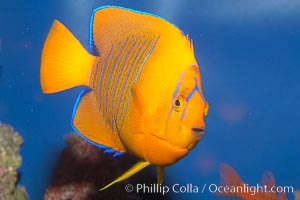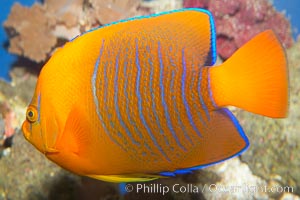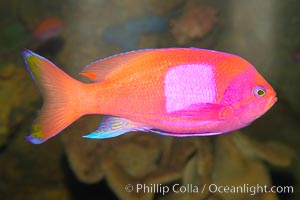
Square-spot fairy basslet, male coloration.
Species: Square-spot fairy basslet, Pseudanthias pleurotaenia
Image ID: 12864
Species: Square-spot fairy basslet, Pseudanthias pleurotaenia
Image ID: 12864
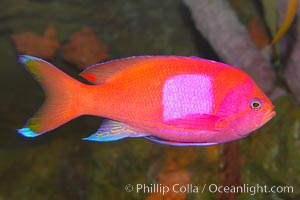
Square-spot fairy basslet, male coloration.
Species: Square-spot fairy basslet, Pseudanthias pleurotaenia
Image ID: 12865
Species: Square-spot fairy basslet, Pseudanthias pleurotaenia
Image ID: 12865
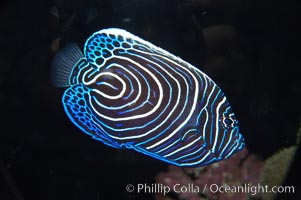
Emperor angelfish, juvenile coloration.
Species: Emperor angelfish, Pomacanthus imperator
Image ID: 13742
Species: Emperor angelfish, Pomacanthus imperator
Image ID: 13742
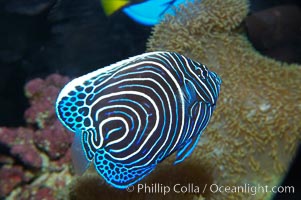
Emperor angelfish, juvenile coloration.
Species: Emperor angelfish, Pomacanthus imperator
Image ID: 13743
Species: Emperor angelfish, Pomacanthus imperator
Image ID: 13743
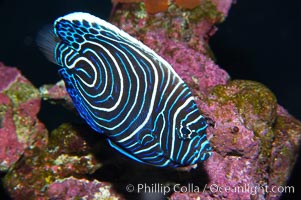
Emperor angelfish, juvenile coloration.
Species: Emperor angelfish, Pomacanthus imperator
Image ID: 13744
Species: Emperor angelfish, Pomacanthus imperator
Image ID: 13744
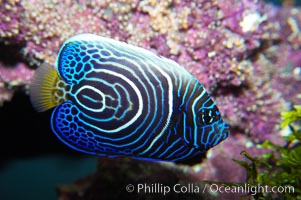
Emperor angelfish, juvenile coloration.
Species: Emperor angelfish, Pomacanthus imperator
Image ID: 13745
Species: Emperor angelfish, Pomacanthus imperator
Image ID: 13745
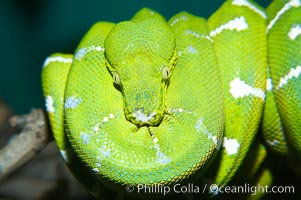
Emerald tree boa. Emerald tree boas are nocturnal, finding and striking birds and small mammals in complete darkness. They have infrared heat receptors around their faces that allow them to locate warm blooded prey in the dark, sensitive to as little as 0.4 degrees of Fahrenheit temperature differences.
Species: Emerald tree boa, Corralus caninus
Image ID: 13965
Species: Emerald tree boa, Corralus caninus
Image ID: 13965
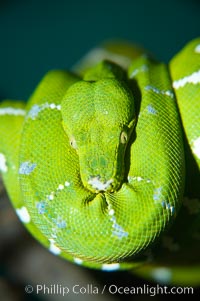
Emerald tree boa. Emerald tree boas are nocturnal, finding and striking birds and small mammals in complete darkness. They have infrared heat receptors around their faces that allow them to locate warm blooded prey in the dark, sensitive to as little as 0.4 degrees of Fahrenheit temperature differences.
Species: Emerald tree boa, Corralus caninus
Image ID: 13966
Species: Emerald tree boa, Corralus caninus
Image ID: 13966
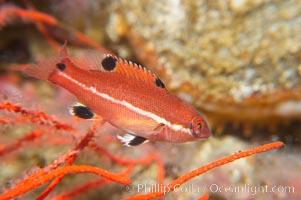
Juvenile sheephead wrasse.
Species: California sheephead wrasse, Semicossyphus pulcher
Image ID: 14001
Species: California sheephead wrasse, Semicossyphus pulcher
Image ID: 14001
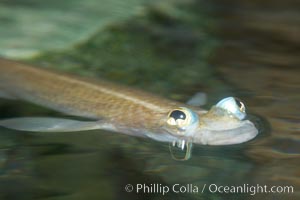
Four-eyed fish, found in the Amazon River delta of South America. The name four-eyed fish is actually a misnomer. It has only two eyes, but both are divided into aerial and aquatic parts. The two retinal regions of each eye, working in concert with two different curvatures of the eyeball above and below water to account for the difference in light refractivity for air and water, allow this amazing fish to see clearly above and below the water surface simultaneously.
Species: Four-eyed fish, Anableps anableps
Image ID: 14719
Species: Four-eyed fish, Anableps anableps
Image ID: 14719
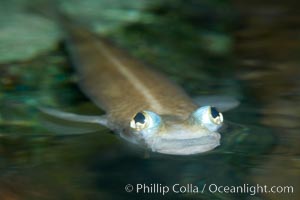
Four-eyed fish, found in the Amazon River delta of South America. The name four-eyed fish is actually a misnomer. It has only two eyes, but both are divided into aerial and aquatic parts. The two retinal regions of each eye, working in concert with two different curvatures of the eyeball above and below water to account for the difference in light refractivity for air and water, allow this amazing fish to see clearly above and below the water surface simultaneously.
Species: Four-eyed fish, Anableps anableps
Image ID: 14720
Species: Four-eyed fish, Anableps anableps
Image ID: 14720
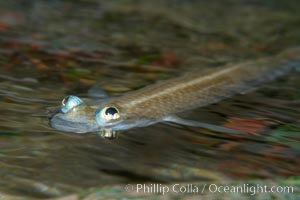
Four-eyed fish, found in the Amazon River delta of South America. The name four-eyed fish is actually a misnomer. It has only two eyes, but both are divided into aerial and aquatic parts. The two retinal regions of each eye, working in concert with two different curvatures of the eyeball above and below water to account for the difference in light refractivity for air and water, allow this amazing fish to see clearly above and below the water surface simultaneously.
Species: Four-eyed fish, Anableps anableps
Image ID: 14721
Species: Four-eyed fish, Anableps anableps
Image ID: 14721
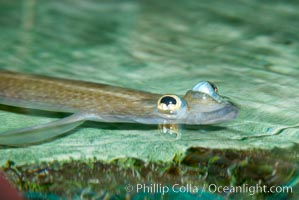
Four-eyed fish, found in the Amazon River delta of South America. The name four-eyed fish is actually a misnomer. It has only two eyes, but both are divided into aerial and aquatic parts. The two retinal regions of each eye, working in concert with two different curvatures of the eyeball above and below water to account for the difference in light refractivity for air and water, allow this amazing fish to see clearly above and below the water surface simultaneously.
Species: Four-eyed fish, Anableps anableps
Image ID: 14722
Species: Four-eyed fish, Anableps anableps
Image ID: 14722
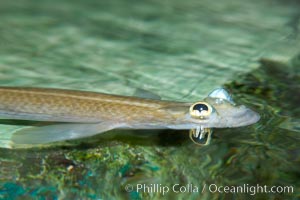
Four-eyed fish, found in the Amazon River delta of South America. The name four-eyed fish is actually a misnomer. It has only two eyes, but both are divided into aerial and aquatic parts. The two retinal regions of each eye, working in concert with two different curvatures of the eyeball above and below water to account for the difference in light refractivity for air and water, allow this amazing fish to see clearly above and below the water surface simultaneously.
Species: Four-eyed fish, Anableps anableps
Image ID: 14723
Species: Four-eyed fish, Anableps anableps
Image ID: 14723
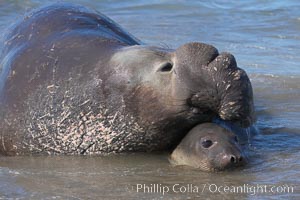
Elephant seals in the surf, showing extreme dimorphism, males (5000 lb) are triple the size of females (1700 lb). Central California.
Species: Elephant seal, Mirounga angustirostris
Location: Piedras Blancas, San Simeon, California
Image ID: 15404
Species: Elephant seal, Mirounga angustirostris
Location: Piedras Blancas, San Simeon, California
Image ID: 15404
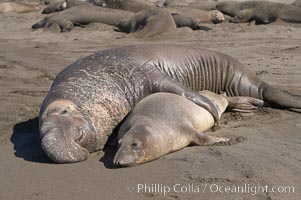
A bull elephant seal forceably mates (copulates) with a much smaller female, often biting her into submission and using his weight to keep her from fleeing. Males may up to 5000 lbs, triple the size of females. Sandy beach rookery, winter, Central California.
Species: Elephant seal, Mirounga angustirostris
Location: Piedras Blancas, San Simeon, California
Image ID: 15446
Species: Elephant seal, Mirounga angustirostris
Location: Piedras Blancas, San Simeon, California
Image ID: 15446
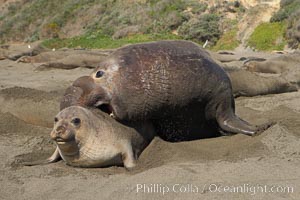
A bull elephant seal forceably mates (copulates) with a much smaller female, often biting her into submission and using his weight to keep her from fleeing. Males may up to 5000 lbs, triple the size of females. Sandy beach rookery, winter, Central California.
Species: Elephant seal, Mirounga angustirostris
Location: Piedras Blancas, San Simeon, California
Image ID: 15448
Species: Elephant seal, Mirounga angustirostris
Location: Piedras Blancas, San Simeon, California
Image ID: 15448
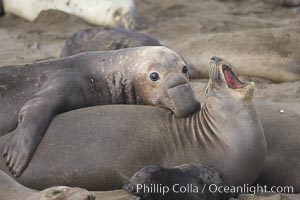
A bull elephant seal forceably mates (copulates) with a much smaller female, often biting her into submission and using his weight to keep her from fleeing. Males may up to 5000 lbs, triple the size of females. Sandy beach rookery, winter, Central California.
Species: Elephant seal, Mirounga angustirostris
Location: Piedras Blancas, San Simeon, California
Image ID: 20389
Species: Elephant seal, Mirounga angustirostris
Location: Piedras Blancas, San Simeon, California
Image ID: 20389
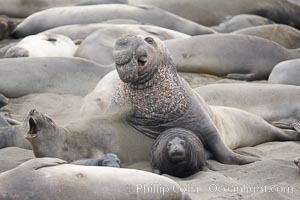
A bull elephant seal approaches a female before forceably mating (copulating) with her, in spite of nearly smashing the female's pup in the process.
Species: Elephant seal, Mirounga angustirostris
Location: Piedras Blancas, San Simeon, California
Image ID: 20390
Species: Elephant seal, Mirounga angustirostris
Location: Piedras Blancas, San Simeon, California
Image ID: 20390
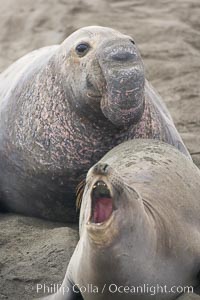
A bull elephant seal eyes a female before forceably mating (copulating) with her.
Species: Elephant seal, Mirounga angustirostris
Location: Piedras Blancas, San Simeon, California
Image ID: 20417
Species: Elephant seal, Mirounga angustirostris
Location: Piedras Blancas, San Simeon, California
Image ID: 20417
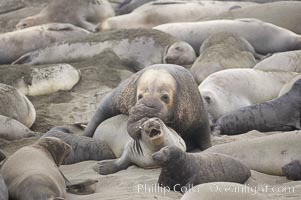
A bull elephant seal forceably mates (copulates) with a much smaller female, often biting her into submission and using his weight to keep her from fleeing. Males may up to 5000 lbs, triple the size of females. Sandy beach rookery, winter, Central California.
Species: Elephant seal, Mirounga angustirostris
Location: Piedras Blancas, San Simeon, California
Image ID: 20428
Species: Elephant seal, Mirounga angustirostris
Location: Piedras Blancas, San Simeon, California
Image ID: 20428
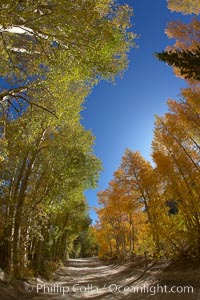
A tunnel of aspen trees, on a road alongside North Lake. The aspens on the left are still green, while those on the right are changing to their fall colors of yellow and orange. Why the difference?.
Species: Aspen, Populus tremuloides
Location: Bishop Creek Canyon, Sierra Nevada Mountains, California
Image ID: 23342
Species: Aspen, Populus tremuloides
Location: Bishop Creek Canyon, Sierra Nevada Mountains, California
Image ID: 23342
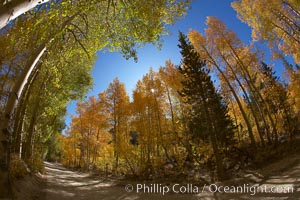
A tunnel of aspen trees, on a road alongside North Lake. The aspens on the left are still green, while those on the right are changing to their fall colors of yellow and orange. Why the difference?.
Species: Aspen, Populus tremuloides
Location: Bishop Creek Canyon, Sierra Nevada Mountains, California
Image ID: 23384
Species: Aspen, Populus tremuloides
Location: Bishop Creek Canyon, Sierra Nevada Mountains, California
Image ID: 23384
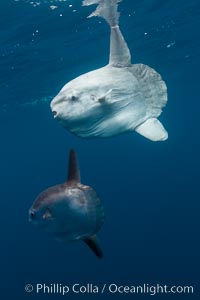
Ocean sunfish, juvenile and adult showing distinct differences in appearance, open ocean.
Species: Ocean sunfish, Mola mola
Location: San Diego, California
Image ID: 26052
Species: Ocean sunfish, Mola mola
Location: San Diego, California
Image ID: 26052
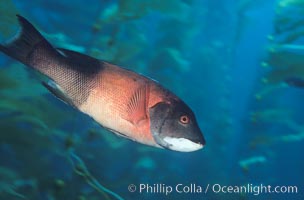
California sheephead, adult male.
Species: California sheephead wrasse, Semicossyphus pulcher
Location: San Clemente Island, California
Image ID: 01936
Species: California sheephead wrasse, Semicossyphus pulcher
Location: San Clemente Island, California
Image ID: 01936
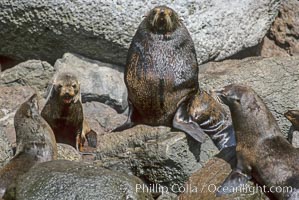
Adult male Guadalupe fur seal with females and pups.
Species: Guadalupe fur seal, Arctocephalus townsendi
Location: Guadalupe Island (Isla Guadalupe), Baja California, Mexico
Image ID: 03743
Species: Guadalupe fur seal, Arctocephalus townsendi
Location: Guadalupe Island (Isla Guadalupe), Baja California, Mexico
Image ID: 03743
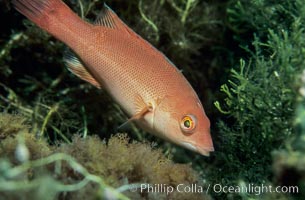
Juvenile sheephead, Farnsworth Banks.
Species: California sheephead wrasse, Semicossyphus pulcher
Location: Catalina Island, California
Image ID: 05184
Species: California sheephead wrasse, Semicossyphus pulcher
Location: Catalina Island, California
Image ID: 05184
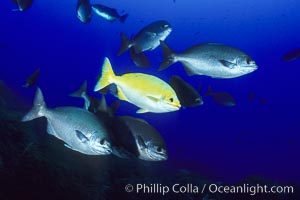
Cortez chubb including golden phase.
Species: Cortez chubb, Kyphosus elegans
Location: Guadalupe Island (Isla Guadalupe), Baja California, Mexico
Image ID: 06179
Species: Cortez chubb, Kyphosus elegans
Location: Guadalupe Island (Isla Guadalupe), Baja California, Mexico
Image ID: 06179
